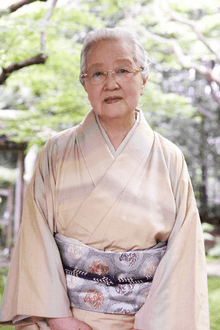Fukumi Shimura
Fukumi Shimura (志村ふくみ; born 1924) is a Japanese textile artist who created kimonos since 1958. Shimura was awarded multiple honours including the Living National Treasure in 1990 and the 2014 Kyoto Prize in Arts and Philosophy.
Fukumi Shimura | |
|---|---|
 | |
| Born | 1924 (age 95–96) Omihachiman, Japan |
| Nationality | Japanese |
| Movement | Mingei |
| Awards | Kyoto Prize in Arts and Philosophy 2014 |
Early life and education
Shimura was born in 1924 in Omihachiman, Japan. She completed her education at Bunka Gakuin in 1942.[1]
Career
In 1955, Shimura began working in textile art.[2] After meeting the Japanese artist Tatsuaki Kuroda, Shimura participated in an art event held by the Japan Kōgei Association in 1957. During her career, Shimura studied under artists Toshijiro Inagaki and Tomimoto Kenkichi.[3] She has created numerous kimonos since her first work in 1958 entitled "Autumn Mist".[1]
In 2015, Shimura's art was shown at the Museum of Modern Art, Shiga.[4] In 2016, Shimura had exhibitions at the National Museum of Modern Art, Kyoto [5] and the Okinawa Prefectural Museum.[2]
Apart from her creations in textile art, Shimura created spaces for textile art learning with her daughter.[1] In 1989, Shimura and her daughter opened up a work space for textile art and a religious spot for weaving in 2013. Shimura also wrote books that were awarded the Nihon Essayist Club Prize and the Osaragi Jirō Prize.[6]
Awards and honors
Shimura was awarded the Medal with Purple Ribbon in 1986, named a Living National Treasure in 1990 and given the Person of Cultural Merit honor in 1993.[1] Other honors Shimura was bestowed with include the 2014 Kyoto Prize in Arts and Philosophy and the Order of Culture the following year.[7]
Personal life
Shimura is the mother of Yoko Shimura, who is also a textile artist.[3]
References
- "Fukumi Shimura". Kyoto Prize. Retrieved 11 February 2018.
- Shioda, Miki (19 May 2016). "Fukumi Shimura's naturally dyed kimonos on exhibit". Japan Update. Retrieved 11 February 2018.
- Larking, Matthew (1 March 2016). "The dyeing art of Japan's traditional everyday kimono". Japan Times. Retrieved 11 February 2018.
- Daisuke, Kikuchi (11 August 2015). "'Shimura Fukumi: Nature and Inheritance to Next Generation'". Japan Times. Retrieved 11 February 2018.
- "Shimura Fukumi". National Museum of Modern Art, Kyoto. Retrieved 11 February 2018.
- "Past Exhibition". Shiseido Gallery. Retrieved 14 February 2018.
- Yoneda, Melynie (2 February 2016). "'Shimura Fukumi'". Japan TImes. Retrieved 11 February 2018.